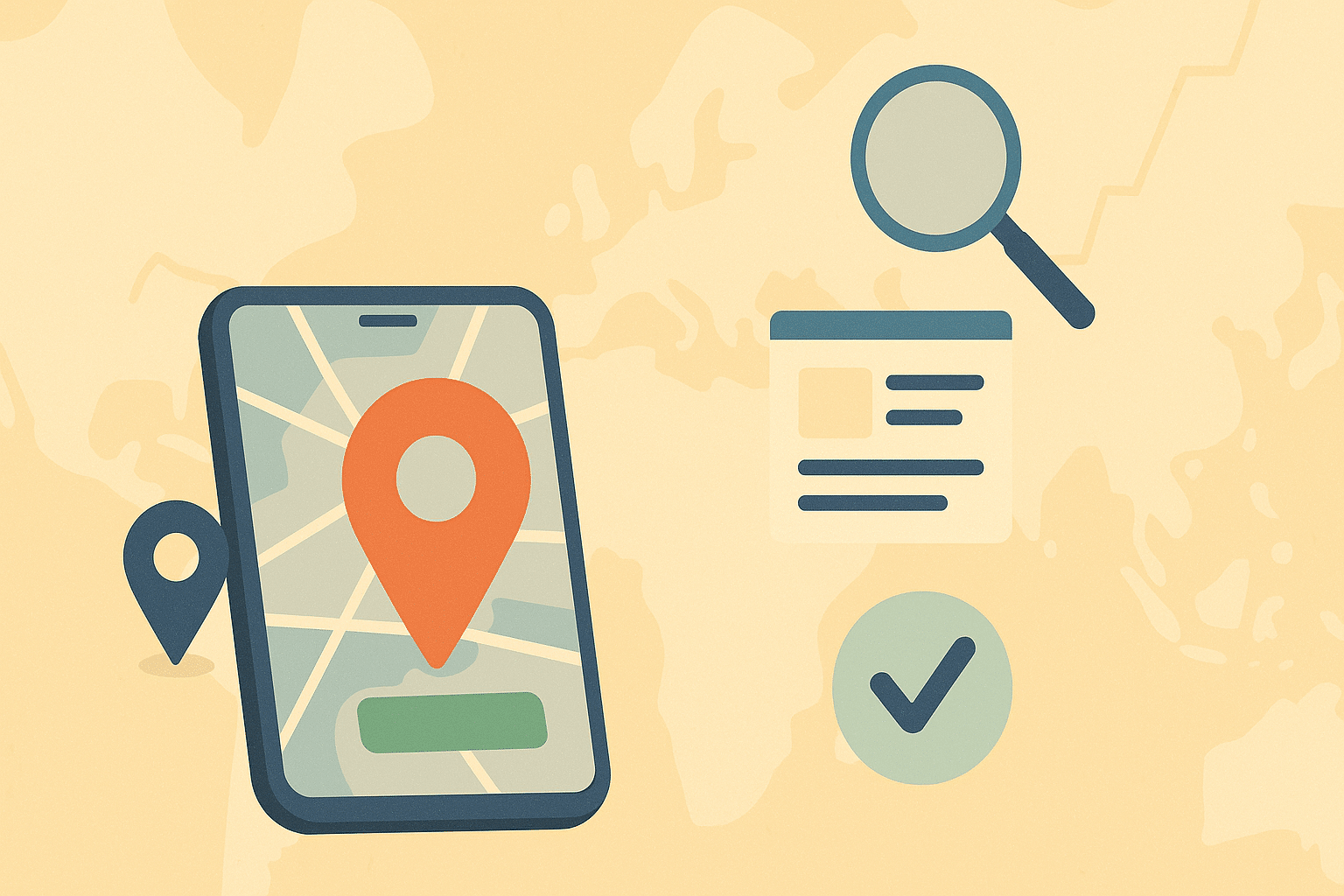Local search engine optimization is the method of improving how a business shows up in local search results. It targets searches that include city names or phrases like near me. This helps small shops, service providers, and local brands get seen on Google Maps, Local Pack, and regular search pages. The goal is to reach people searching in their area and bring them to a nearby business.
Nearly 46 percent of Google searches have local intent, which shows why local SEO matters. It works across Google, Bing, and other directories that use location signals to show nearby options. For any business that depends on nearby customers, local SEO is a key strategy.
How local SEO developed over time
Local search engine optimization began to take shape in the mid-2000s when search engines started showing results based on geographic location. Around 2004 and 2005, major platforms like Google and Bing created local business listings and added mapping features to match local intent queries.
Google’s local platform evolution
In 2005, Google introduced Local Business Center, allowing owners to control how their location appeared on Google Maps. This tool went through several changes:
- Renamed to Google Places in 2009
- Shifted to Google+ Local in 2011
- Became Google My Business in 2014
- Rebranded as Google Business Profile in 2021
Each version gave businesses more control over their local presence in search.
Rise of the Local Pack and algorithm updates
By the late 2000s, Google began showing a Local Pack—a set of map-based results for local queries. Earlier packs showed 7 to 10 results. This changed to the 3-pack format, now standard for most local searches.
Google’s local algorithm updates shaped how results appear:
- Pigeon update (2014): Merged local signals with Google’s main search algorithm to improve relevance.
- Possum update (2016): Improved visibility for businesses outside city limits and filtered duplicate listings.
- Hawk update (2017): Adjusted filters so nearby businesses (within a few hundred feet) could appear together.
- Bedlam update (2019): Introduced neural matching to help Google understand relevance beyond keywords.
- Vicinity update (2021): Gave more weight to proximity and reduced the impact of keyword stuffing in business names.
Other platforms and user behavior
Other companies also developed local features:
- Bing Places for Business offers location listing tools.
- Apple Maps listings are managed through Apple Business Connect.
Despite this, Google remains the main focus for local SEO. By the mid-2020s, nearly 88 percent of users rely on Google Maps to find nearby businesses, while Apple Maps is used by about 12 percent.
Because of Google’s dominance, most local SEO strategies follow changes in the Google Business Profile system and local search updates.
What is included in local SEO results
When a user types a search with local intent, search engines usually show two kinds of results: the local pack and the localized organic results.
Local pack (Map Pack)
The local pack, also known as the 3-pack, is a highlighted box that shows a map and three business listings. Each listing includes:- Business name , Address , Phone number , Review rating , Often a photo or logo
These entries come from the search engine’s local business database. For Google, this means the Google Business Profile. Clicking on a listing or the map opens more details in Google Maps, including directions, reviews, photos, and Q&A.
To appear in the local pack, a business usually needs a Google Business Profile. The data shown is pulled from:-The profile itself (categories, hours, photos, etc.) , User-submitted updates , Third-party sources like Wikipedia or online directories
On the desktop, Google used to show the map above the listings. A 2021 update moved the map to the right side and listings to the left, matching the mobile layout.
Localized organic results
Beneath or next to the pack, users see localized organic results. These are the usual web listings, but filtered based on local intent. For example, a search for plumbers in Dallas will show plumbers located in Dallas rather than general plumbing websites.
This section often includes:- Business websites , Directory pages (like Yelp, TripAdvisor, or Yellow Pages) , Local guides or listings
The organic results use the regular search algorithm, adjusted to factor in location. A business may appear both in the local pack and in the organic results, but these are separate ranking systems. Ranking in one does not mean ranking in the other.
How local SEO rankings are decided

Search engines use a mix of signals to decide how businesses rank in local search. Google officially recognises three main factors: relevance, distance, and prominence.
- Relevance
Relevance measures how closely a business profile matches what the user is searching for. A complete profile helps the search engine understand the services or products offered.
For example, if someone searches for a vegan bakery, the chances of ranking improve if the business clearly lists vegan items. Businesses that leave fields empty or unclear may not appear for important queries.
- Distance
Distance refers to how far the business is from the user or the location mentioned in the search. If no location is typed, Google estimates the user’s position using device location.
The 2021 Vicinity update gave even more importance to proximity, making physical closeness a stronger signal than before. Two businesses offering similar services may rank differently based on how near they are to the searcher.
- Prominence
Prominence reflects how well-known a business is. This can come from reviews, online mentions, or overall reputation. A business with more positive Google reviews, active local citations, and mentions on respected websites is likely to be seen as more prominent.
Older businesses with a long-standing presence and those with strong backlinks also tend to rank better in both map and organic results.
Additional ranking signals
Beyond the official factors, many other signals influence rankings. Industry studies highlight that the primary category chosen in the business profile, keywords in the business name, and having an address inside the searched city can affect visibility. A high number of positive reviews and the use of extra attributes like “open 24 hours” also support ranking strength.
For local organic results, Google relies more on standard website SEO. Websites that have separate pages for each service or city, use location keywords clearly, and get links from trusted sources tend to perform better. On-page structure, content quality, and local relevance all contribute to stronger rankings.
Role of NAP consistency
NAP stands for Name, Address, and Phone number. Keeping this information the same across the website, business profile, and other directories helps search engines confirm the business identity.
In earlier years, inconsistent NAP data was one of the main causes of poor local ranking. Today, search engines tolerate small differences better, but keeping consistent records is still a basic part of good local SEO.
Together, these ranking signals shape how a business appears in the local pack and the standard local results. Maintaining accurate details and offering useful content both help improve visibility.
How to improve local search visibility
Local SEO combines on-page and off-page efforts to improve visibility in location-based search results. Each part of the strategy supports how search engines understand a business and how users find it. Below are the core methods used to build a strong local presence.
Google Business Profile optimization
The Google Business Profile (GBP) is a major part of local SEO. Since Google’s Local Pack and Google Maps pull business data from GBP, keeping this profile complete and accurate is essential. Businesses should claim and verify their listing, then fill out all key details such as name, address, phone number, hours, and business category.
Choosing the correct category matters because it directly affects relevance in local searches. Adding features like attributes (e.g. outdoor seating, wheelchair access), photos, videos, and regular updates makes the profile more appealing. Businesses that post updates, reply to questions, and add fresh photos show they are active, which helps with both trust and visibility.
Local citations and business directories
A citation is any mention of a business’s name, address, and phone number on another website. These appear on platforms like Yelp, Yellow Pages, TripAdvisor, Bing Places, Facebook, and industry directories. Having consistent listings across these platforms builds trust and supports local prominence.
While the number of citations is less important than before, getting listed on authoritative websites still improves credibility. For example, being listed on a site like the Better Business Bureau or a known industry site can help reinforce a business’s legitimacy in both the eyes of search engines and users.
Managing reviews and ratings
Online reviews play a large role in local SEO. Google clearly states that more reviews and higher ratings can help a business rank better. Businesses are encouraged to ask customers for honest reviews, especially on Google, but also on Facebook and other relevant platforms.
Responding to reviews—both good and bad—can also support local performance. When businesses reply to feedback professionally, it shows users that the brand is active and trustworthy. This builds a good reputation and may influence users to choose that business over others.
On-page optimization for local relevance
A business’s own website also needs to be set up for local search. This includes adding NAP information in a clear format, usually in the footer or contact page. Using structured data (LocalBusiness schema) helps search engines understand the business location and services.
Creating separate pages for each city or area served can improve performance, especially if each page includes local keywords. For example, a service provider might make individual pages for “Car repair in Noida” and “Car repair in Ghaziabad.” Using the city name in headings, title tags, and content—where natural—shows relevance to the area.
Websites should also load fast and work well on mobile, as most local searches now happen on phones. A mobile user may be looking for something urgent, like a phone number or address, so the site must be easy to use and quick to open.
Local backlinks and community links
Links from local websites help build location-specific authority. Businesses can earn links through local media coverage, event sponsorships, local blog features, or partnerships with nearby businesses. These backlinks support both traditional SEO and location relevance.
Being involved in community groups, business networks, or local chambers of commerce can also lead to listings and links. For example, a restaurant partnering with a local delivery app may receive a link on their partner’s website, which helps both visibility and trust.
Social media pages may not directly affect Google’s rankings, but they help with local discovery. Active profiles on platforms like Facebook, Instagram, and YouTube can appear in branded search results. These profiles also help users learn more about the business and connect with it directly.
User engagement on social media—such as check-ins, shares, or comments—can increase online activity around the business, which may support its visibility across platforms.
Adapting to new search behavior
Voice search and “near me” queries are now part of modern local SEO. Many users ask full questions, such as “Where can I get a haircut near me?” To match this behavior, businesses create FAQ sections or use natural language in their content.
Location-specific features, like correct driving directions on Google Maps or click-to-call buttons on mobile, also help with user experience. Since most users want quick answers on the go, technical setup and clear information are now central to local SEO performance.
By keeping both the profile and website aligned, and by staying active in the local digital space, businesses can improve how and where they appear in local search results.
Common issues in local search optimization
Local SEO comes with specific challenges, especially because top local positions can bring significant visibility and business growth. This high value creates opportunities for abuse, and maintaining quality in local search results continues to be a work in progress.
Spam and fake listings
One of the biggest issues in local SEO is the spread of spam listings. These are fake or misleading business profiles created to manipulate rankings. In some cases, real businesses add unrelated keywords or city names to their name field on Google Business Profile, violating Google’s naming guidelines. This tactic was common before Google’s Vicinity update, which reduced the effect of such keyword stuffing.
Although Google has policies to prevent misleading edits, enforcement is not always reliable. The balance between algorithm improvements and spam tactics remains ongoing, with both sides constantly adapting.
Fake reviews
Another serious concern is the use of fake reviews. Some businesses may pay for fake 5-star reviews to boost their reputation or post negative reviews about competitors. These reviews can mislead users and may affect rankings.
Google uses filters and allows users to report fake reviews, but detection is not perfect. Local SEO expert Joy Hawkins has pointed out the difficulty of removing fake reviews from a competitor’s listing. Google has updated its review policies and detection methods over time, and in some cases, taken legal action against large fake review networks. Still, moderation at scale remains a challenge.
Accuracy of business information
Google pulls local data from several sources, including:
- The business owner’s profile
- User-generated edits
- Third-party directories
- Web crawling
Because of this, information may go out of date or get changed without notice. For example, business hours might be changed by user edits, or a phone number may be updated based on old directory data. To avoid confusion, businesses need to actively manage their profile and check listings across other platforms.
Competitive pressure and listing sabotage
Local SEO is highly competitive, especially in fields like law, health, or home services. Since only a few listings appear in the Local Pack, businesses sometimes face unethical tactics from competitors. These may include:
- Malicious edits suggesting a business is permanently closed
- Creating dummy listings to crowd search results
- Repeatedly suggesting edits to weaken a rival’s profile
Although Google has systems like the Local Guide program to review user edits, these systems can still be gamed. Businesses must regularly monitor their listings for unexpected changes.
Algorithm updates and shifting priorities
Google frequently adjusts its local search algorithm. A factor like citation count may lose impact as other signals gain importance. Updates like Pigeon, Possum, and Vicinity have reshaped how results are ranked, often without much warning. These changes can shift traffic patterns overnight, requiring businesses to adjust quickly.
Ongoing need for monitoring
Because of these variables, local SEO is not a one-time task. It demands continuous effort, especially for businesses in highly contested markets. The best approach includes:
- Following Google’s guidelines
- Avoiding grey-area tactics
- Staying updated with industry news
- Regularly auditing business listings and search performance
A consistent, compliant, and active local presence is the best way to stay competitive while avoiding penalties.
Benefits of local search engine optimization

Local SEO plays a key role in connecting businesses with nearby customers. It affects real-world visits, builds trust, and helps small businesses compete effectively in crowded search spaces.
Real-time customer intent
People use local search when they are ready to take action. According to Google, 76 percent of users who search for something nearby on a mobile phone visit a business within 24 hours. This shows strong buying intent behind local queries.
Even a single appearance in the local 3-pack or map results can result in:
- A store visit
- A phone call
- A direct purchase or booking
This immediacy makes local SEO critical for customer-facing businesses.
Local SEO supports small business visibility
Competing with national brands is difficult for small businesses. Local SEO gives them a chance to rank for location-specific keywords, like:
- “best paratha in Connaught Place”
- “plumber near me”
- “dentist in Rajkot”
These searches allow smaller shops, cafés, and service providers to build trust and become visible to people nearby. Businesses with strong reviews and good map visibility often become known as local favourites, leading to repeat visits.
Organic reach and local advertising work together
While Google offers location-based ads and promoted pins in Google Maps, many users still prefer organic listings. A well-optimized Google Business Profile with good ratings often builds more trust than a paid ad.
Businesses that appear both in local ads and organic 3-pack listings benefit from:
- Broader visibility across the page
- Better credibility through reviews
- More customer engagement and trust
Evolving search habits and optimization needs
Search behavior is shifting. Users now search through:
- Voice assistants
- Mobile phones
- “Near me” phrases
This requires businesses to use natural language, build FAQ pages, and include hyper-local content on their websites.
Building community presence
Good local SEO also strengthens a business’s connection to the local area. High rankings, positive reviews, and updated listings help a business become part of the community. This results in better brand recall, stronger word of mouth, and more customer loyalty.
References
- https://clever-clicks.co.uk/blog/local-seo-stats-2024/
- https://en.wikipedia.org/wiki/Local_search_engine_optimisation
- https://www.americaneagle.com/insights/blog/post/the-history-of-local-seo
- https://searchengineland.com/heres-what-you-need-to-know-about-googles-newest-algorithm-update-possum-2-0-324927
- https://www.seroundtable.com/google-november-2019-google-local-update-confirmed-28624.html
- https://www.brightlocal.com/research/november-2019-local-algorithm-fluctuation/
- https://www.brightlocal.com/blog/google-confirms-biggest-local-search-algorithm-update-in-five-years/
- https://www.yext.com/blog/google-vicinity-update-e9f67e344a35
- https://support.google.com/business/answer/7091
- https://searchengineland.com/2023-survey-local-search-ranking-factors-394839
- https://localsearchforum.com/threads/local-ranking-problems-poll-citation-inconsistency-is-1-issue.49315/
- https://www.searchenginejournal.com/local-seo/what-is-local-seo-why-local-search-is-important/


